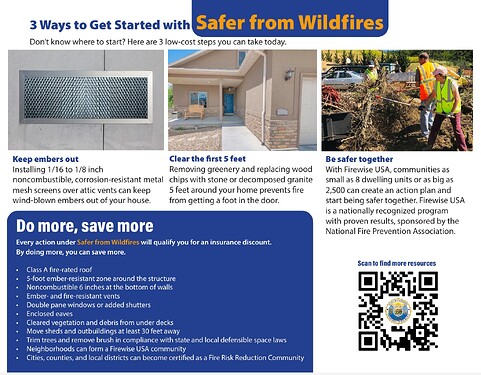Whether your home to properly hardened to receive embers will determine how likely it is to survive a wildfire. The percentage of houses hardened to receive embers in a neighborhood will, in turn, determine if this neighborhood is resilient to fire or should simply be abandoned as indefensible.
The California Department of Insurance (CDI) has developed a ten-point list that constitues the CDI standard for homes that are prepared to receive embers:
- Class-A fire rated roof – Most roofs qualify including asphalt shingles, concrete, brick, or masonry tiles, and metal shingles or sheets. Wood shake shingles are not Class A fire-resistant rated. The Office of the State Fire Marshal maintains a list of tested and approved materials.
- 5 foot ember resistant zone, including fencing – Removing greenery and replacing wood chips with stone or decomposed granite 5 feet around your home prevents fire from getting a foot in the door. Replacing wood fencing connecting to your home with metal is critical because it can act like a candle wick leading fire straight to your home.
- Ember- and fire-resistant vents – Installing 1/16 to 1/8 inch noncombustible, corrosion-resistant metal mesh screens over exterior vents can keep wind-blown embers out of your house.
- Non-combustible 6 inches at the bottom of exterior walls – Having a minimum of 6 vertical inches measured from the ground up and from any attached horizontal surface like a deck can stop embers from accumulating and igniting your walls. Noncombustible materials include brick, stone, fiber-cement siding or concrete.
- Enclosed eaves – Installing soffits under your eaves can prevent heat and embers from getting trapped and igniting. When enclosing eaves, non-combustible or ignition resistant materials are recommended.
- Upgraded windows – Multi-paned windows are more resistant to breaking during a wildfire, which helps keep flames from entering. Multi-paned glass or added shutters all qualify.
- Cleared vegetation, weeds and debris from under decks – Noncombustible materials like concrete, gravel, or bare soil are permitted.
- Removal of combustible sheds and other outbuildings to at least a distance of 30 feet – These include sheds, gazebos, accessory dwelling units (ADUs), open covered structures with a solid roof, dog houses and playhouses.
- Defensible space compliance – following state and local laws requiring defensible space including trimming trees and removal of brush and debris from yard. See CAL FIRE’s defensible space page and BFD’s Self-Inspection Checklist [PDF]. [Note: For us in Berkeley, since Zone 0 is already dealt with in another bullet point, this means compliance with Zone 1 and Zone 2 requirements.]
- Being safer together – Safer from Wildfires recognizes two community-wide programs, Firewise USA and Fire Risk Reduction Communities as small as 8 dwelling units or as big as 2,500 can create an action plan and start being safer together. Firewise USA is a nationally recognized program with proven results, sponsored by the National Fire Prevention Association. Being a member of one of these two communities qualifies your home for this point.
Today, BFD’s self-inspection checklists recommends the CDI standard. In the future, it may someday require it. If your home is not prepared to receive embers to CDI standards, your likelihood of insurance non-renewal goes up rapidly—and, as we all know, few insurers now write new policies in California. So save yourself a bunch of trouble and retrofit your home so that is hardened to CDI standards.
